NDVI stands for "Normalized Difference Vegetation Index". NRG stands for "Near-infrared / Red / Green". NDVI and NRG are both ways to visualize the amounts of infrared and other wavelengths of light reflected from vegetation. Because both these methods compare ratios of blue and red light absorbed versus green and IR light reflected, they can be used to evaluate the health of vegetation. It's a snapshot of how much photosynthesis is happening. This is helpful in assessing vegetative health or stress. (Read more here: https://www.agronomy.org/publications/jeq/articles/36/3/832) ## Do-It-Yourself These techniques for vegetation analysis were developed for satellite imagery, but at Public Lab, we've been working a lot on capturing infrared imagery using our DIY [near-infrared camera](/wiki/near-infrared-camera) setup, and combining it with visible bands to produce NDVI images such as the one above. ## What these images mean What exactly are these images we're trying to make? What do they tell us about vegetation, and why? These diagrams should help to understand what it is we're doing and why these are good ways to analyze plant life. ## The NDVI equation [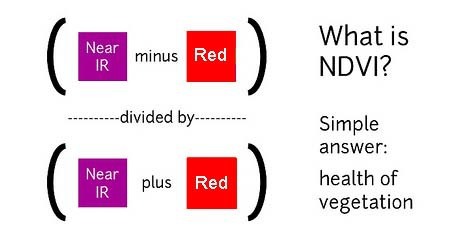](/i/44723) **NDVI = (Near Infrared - Red)/(Near Infrared + Red)** NDVI is a ratio which tries to emphasize photosynthesis while filtering out sun glare. The above equation is run for every pixel, using source data from an infrared photo and a visible light photo, like this pair: [](https://publiclab.org/system/images/photos/000/021/771/original/5390895115_c9d4d38fec_o.jpg) The result can be false-colored to make the high-photosynthesis areas more clear, and used to examine where plants are and how healthy they are. [](https://publiclab.org/system/images/photos/000/021/770/original/PetVISNDVIcomp.png) _Figure above: Normal color photo (right) and normalized difference vegetation index (NDVI) image (left). NDVI image was derived from two color channels in a single photo taken with a camera modified with a special infrared filter. Note that tree trunks, brown grass, and rocks have very low NDVI values because they are not photosynthetic. Healthy plants typically have NDVI values between 0.1 and 0.9. -- @cfastie_ ### Activities Here are a range of activities you can do to produce and interpret your own NDVI imagery, whether downloaded from a satellite imagery provider or [collected yourself using a DIY technique](/wiki/multispectral-imaging) [activities:ndvi] ****   Most DIY converted cameras today (those from Public Lab) use RGN instead of NRG, so the blue channel represents infrared instead of the red channel. That looks like this: [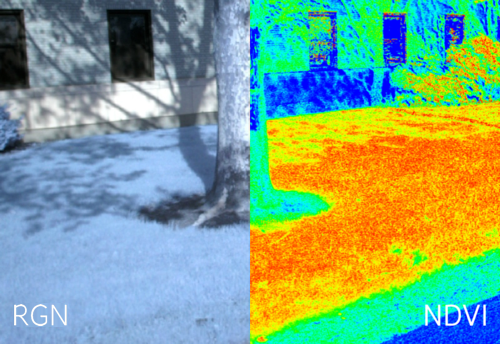](/i/45468?s=o) **** ## NRG imagery Some people are also interested in producing NRG imagery (like the below image), where `Near-Infrared, Red, and Green` are used to compose a picture instead of the usual `Red, Green, and Blue`. [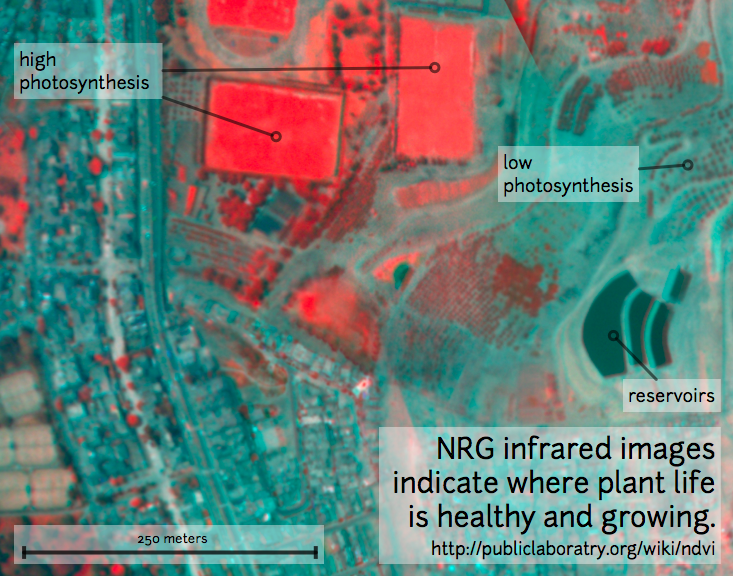](/i/25064) This diagram explains the swapping, which allows us to 'see' infrared as if it were a normal color: [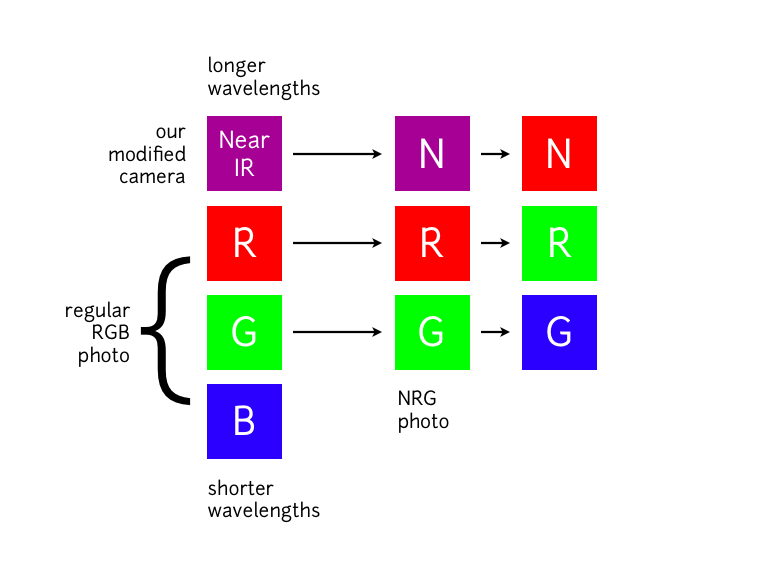](/i/25063) **In NRG images, the deeper and clearer the red color, the denser and healthier the vegetation (more or less).** ### Questions [questions:ndvi] ### Other examples of DIY NDVI imaging From around the internet: Begin watching at 2 minutes to see the resulting imagery: *This topic is part of the [Grassroots Mapping Curriculum](/wiki/mapping-curriculum) series.* **** [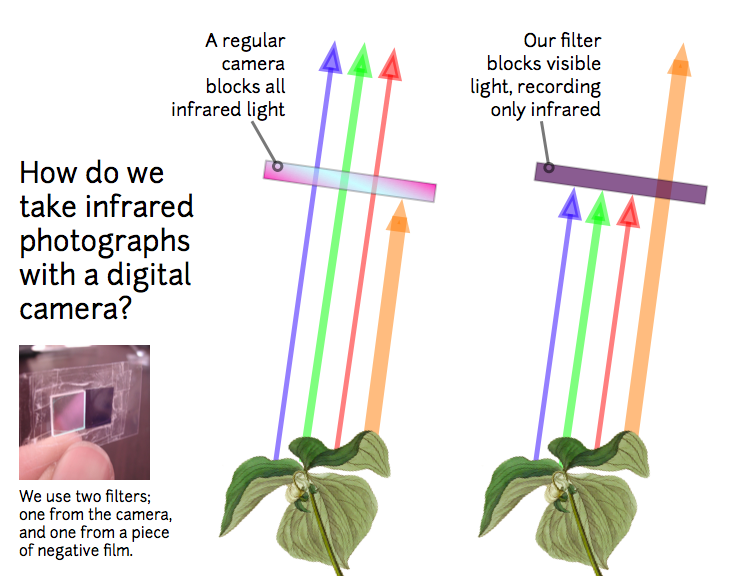](/i/25066) [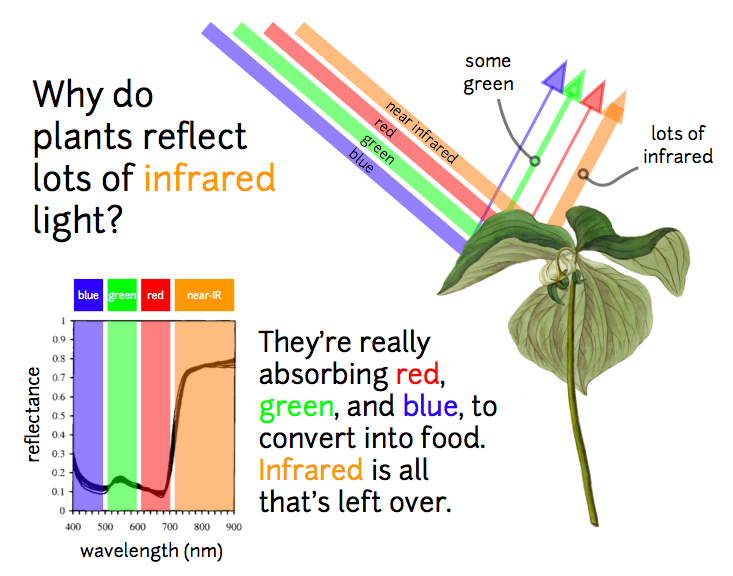](/i/25065) ...
| Author | Comment | Last activity | Moderation | ||
|---|---|---|---|---|---|
| mathew | "This formula doesn't produce anything like NDVI for me. I always get an image that looks the same as unprocessed, with some artifacting. " | Read more » | over 10 years ago | |||
| cfastie | "All three of those filters will probably be good replacements for Wratten 25. Doing some tests with them is the only way to tell, and I suspect it ..." | Read more » | over 10 years ago | |||
| mathew | "Thanks Chris! " | Read more » | over 10 years ago | |||
| cfastie | "That nice windows program for Mobius is not official, just written by the isoprop guy. I guess nobody has done it yet for the Mac. Here is the con..." | Read more » | over 10 years ago | |||
| mathew | "I've been manually editing the config file-- the only thing I can't figure out is how to turn on the custom white balance. " | Read more » | over 10 years ago | |||
| warren | "Shouldn't it be possible to copy the text config file from Chris's mobius and post it here so Mathew can use it? " | Read more » | over 10 years ago | |||
| mathew | "Well, I guess that pretty much settles it on the red. I went out flying with only the blue on friday, and haven't processed the results yet. I wa..." | Read more » | over 10 years ago | |||
| cfastie | "Jeff, all of the photos that day were in bright sunshine under cloudless sky. You can see the afternoon progress in the four panel NDVI for Mobius ..." | Read more » | over 10 years ago | |||
| warren | "Indeed, that last Mobius with a 2007 did not work well for me either. What were the lighting conditions? I tried to stretch the histogram a bit, bu..." | Read more » | over 10 years ago | |||
| erget | "Nice work! I'll be sure to try it out as soon as I've got my 3D printer :) " | Read more » | over 10 years ago | |||
| cfastie | "You're right, that would be a revealing test. In the example you referred to (below), the red channel should be three times more sensitive than th..." | Read more » | over 10 years ago | |||
| cfastie | "Tom, Yes, meaningless was not the best word choice. The real surprise was that the non-plants consistently had NDVI values higher than plants. That..." | Read more » | over 10 years ago | |||
| ttaylor | "you know, if the little color filters in Mobius cmos sensor Bayer array have the same spectral response as some of the CCD sensors I've seen around..." | Read more » | over 10 years ago | |||
| ttaylor | "Wow, that was quick. Too bad about the Mobius not doing raw. I feel like a I have decent handle on the Canons, but the Mobius is so light and po..." | Read more » | over 10 years ago | |||
| ttaylor | "Chris, re the Mobius Rosco2007 image, some comments and questions. By "meaningless" do you mean that the pine board looks so much like the living p..." | Read more » | over 10 years ago | |||
| cfastie | "Tom, Maybe it would also be useful to you to have DNG images (via CHDK) from my full spectrum Canon A810? " | Read more » | over 10 years ago | |||
| cfastie | "Hi Tom, I didn't capture RAW with the S95, and the Mobius does not do RAW (although the firmware is open source, so it's possible). I could capture..." | Read more » | over 10 years ago | |||
| ttaylor | "Chris, do you have raw versions of these images I could look at? " | Read more » | over 10 years ago | |||
| mathew | "Ok-- I have the ROSCO Fire filter and several others in my swatch booklet. Going to run tests tomorrow, and try digging into the white balance pre..." | Read more » | over 10 years ago | |||
| mathew | "I'm matching your process from here- got to go grab the rosco filter packs from storage, but I just printed up that beautiful mount. " | Read more » | over 10 years ago | |||
| mathew | "Nice writeup, thanks Chris. I like the tip on focusing, hadn't tried that. " | Read more » | over 10 years ago | |||
| donblair | "Follow-up -- there's some nice info on IR photodiodes (at least the sort that are in a typical IR remote), here -- including a link to a datasheet...." | Read more » | over 10 years ago | |||
| donblair | "Yay! Yeah, I puzzled a bit over the best geometry of 'emitters and receivers' to use on the device. I have two photodiodes on the board, one of w..." | Read more » | over 10 years ago | |||
| mathew | "The circular layout will make concentrating the different LEDs towards a common point easier. good thinking. " | Read more » | over 10 years ago |